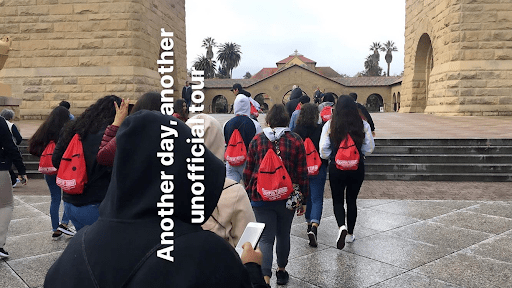“So you do this for free? Why?”
Being an unofficial tour guide, rather than an official tour guide through the Visitor Center, means I have to remain relatively dedicated to giving tours despite not getting paid. Recently, I finished giving my fifteenth unofficial tour, the occasion being the impetus for this Grind article. A lot of my friends ask why I’ve given so many tours, why I’ve given up so much of my time, but the fact of the matter is that I didn’t really know until recently. I simply knew I loved giving unofficial tours.
I think I know now.
It’s quite easy to burn out at Stanford. Day after day, going to class and falling into a routine chips away at your serotonin vaults. I recently learned that days feel like they’re going too quickly when your life has fallen into such a rhythmic routine that you wake up, and the next day is Monday, and the day after that also feels like Monday. So on and so on. It’s only when we break routines that the day feels like it’s gone forever. This is the reason days felt so long for us when we were children. We were still forming memories, while aging causes days to feel shorter.
Giving unofficial tours for me has helped break that curse. While I’m giving a tour to a group, I feel like I’m touring the campus with them for the first time. My favorite moments are when the students ask me a question that I don’t know, followed by a race to our phones to figure out why Stanford has so many Rodin sculptures. There are also other highlights, of course. Another favorite thing I love to do on a tour is asking them how many Disneylands they think fit on our campus. It always starts low with guesses of four and five, and as they learn that 96 Disneylands (roughly equivalent to 41 Berkeleys) fit on our campus, their minds are publicly blown, and they erupt into side conversations of disbelief.
As their faces express excitement and skepticism, there are always some students in the back who lean more towards the latter. They ask about how diverse Stanford truly is and about the fine print (i.e. what are Stanford’s biggest shortcomings). These are some of my favorite questions. So I tell them about the campus culture, and I tell them what they wish to know. I don’t sugarcoat. I tell them the truth about where I perceive Stanford is failing its students, but I also make sure to frame Stanford’s flaws in the context of my friend’s works and efforts to better Stanford. In doing so, many of them jump at some of the words I say and seem interested in a lot of the work Stanford students are doing. A high school junior once came up to me after a tour to tell me to “hold down the fort until I get here.”
I strive to give students the most accurate representation of this university when giving tours, and when I see these students fall in love with Stanford — flaws and all — I see myself in their eyes. I was there not too long ago. I’m here now. Paying it forward really isn’t why I give these tours. I don’t even give these tours to “stroke my ego.” I give these tours because they ground me and connect me to a world outside of Stanford. The high school tour groups remind me of my sister and my brother. They remind me of when I first came to campus with them. They remind me of an innocence I once had, and as an unofficial tour guide, I aim to deliver what I wish I would have known back then. Stanford isn’t perfect, but it is the place for me. It was the place where I felt I could grow with the institution and make a difference.
As an unofficial tour guide, at the end of the day, I know I’ve made all the difference for these kids, and that’s all that matters.
Contact Richard Coca at richcoca ‘at’ stanford.edu.
